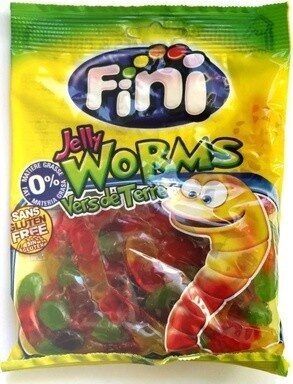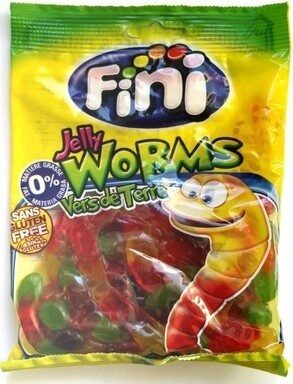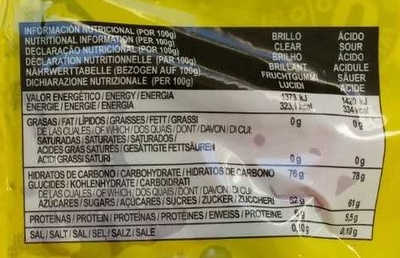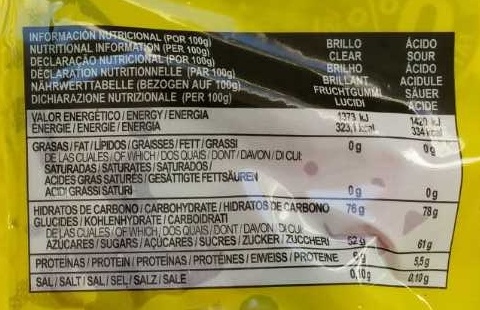Help us make food transparency the norm!
As a non-profit organization, we depend on your donations to continue informing consumers around the world about what they eat.
The food revolution starts with you!
Jelly Worms Vers de Terre - Fini - 200 g e
Jelly Worms Vers de Terre - Fini - 200 g e
This product page is not complete. You can help to complete it by editing it and adding more data from the photos we have, or by taking more photos using the app for Android or iPhone/iPad. Thank you!
×
Barcode: 8410525121944 (EAN / EAN-13)
Common name: Confiserie gélifiée brillante
Quantity: 200 g e
Brands: Fini
Categories: Snacks, Sweet snacks, Confectioneries, Candies, Gummi candies
Labels, certifications, awards:
Low or no fat, No gluten, Green Dot, No fat
Manufacturing or processing places: Espagne
Countries where sold: France
Matching with your preferences
Health
Ingredients
-
40 ingredients
: Confiserie gélifiée brillante : Sirop de glucose, sucre, gélatine, eau, humectant : E420, acidifiants : E330, E270, correcteur d'acidité : E325, arômes, concentrés de fruits et préparation d'extrait végétal (carotte, cassis noire), agents d'enrobage : E901, E903, colorants : curcumine, cochenille, bleu brillant FCF, extrait de paprika. Confiserie gélifié acidulée : Sucre, sirop de glucose, eau, gélatine, acidifiants : E330, E296, E270, correcteur d'acidité : E325, arômes, colorants : curcumine, cochenille, bleu brillant FCF, extrait de paprika.Traces: Milk
Food processing
-
Ultra processed foods
Elements that indicate the product is in the 4 - Ultra processed food and drink products group:
- Additive: E100 - Curcumin
- Additive: E120 - Cochineal
- Additive: E133 - Brilliant blue FCF
- Additive: E160c - Paprika extract
- Additive: E325 - Sodium lactate
- Additive: E420 - Sorbitol
- Additive: E428 - Gelatine
- Additive: E901 - White and yellow beeswax
- Additive: E903 - Carnauba wax
- Ingredient: Colour
- Ingredient: Flavouring
- Ingredient: Glazing agent
- Ingredient: Glucose
- Ingredient: Glucose syrup
- Ingredient: Humectant
Food products are classified into 4 groups according to their degree of processing:
- Unprocessed or minimally processed foods
- Processed culinary ingredients
- Processed foods
- Ultra processed foods
The determination of the group is based on the category of the product and on the ingredients it contains.
Additives
-
E120 - Cochineal
Carminic acid: Carminic acid -C22H20O13- is a red glucosidal hydroxyanthrapurin that occurs naturally in some scale insects, such as the cochineal, Armenian cochineal, and Polish cochineal. The insects produce the acid as a deterrent to predators. An aluminum salt of carminic acid is the coloring agent in carmine. Synonyms are C.I. 75470 and C.I. Natural Red 4. The chemical structure of carminic acid consists of a core anthraquinone structure linked to a glucose sugar unit. Carminic acid was first synthesized in the laboratory by organic chemists in 1991.Source: Wikipedia
-
E133 - Brilliant blue FCF
Brilliant Blue FCF: Brilliant Blue FCF -Blue 1- is an organic compound classified as a triarylmethane dye and a blue azo dye, reflecting its chemical structure. Known under various commercial names, it is a colorant for foods and other substances. It is denoted by E number E133 and has a color index of 42090. It has the appearance of a blue powder. It is soluble in water, and the solution has a maximum absorption at about 628 nanometers.Source: Wikipedia
-
E270 - Lactic acid
Lactic acid: Lactic acid is an organic compound with the formula CH3CH-OH-COOH. In its solid state, it is white and water-soluble. In its liquid state, it is colorless. It is produced both naturally and synthetically. With a hydroxyl group adjacent to the carboxyl group, lactic acid is classified as an alpha-hydroxy acid -AHA-. In the form of its conjugate base called lactate, it plays a role in several biochemical processes. In solution, it can ionize a proton from the carboxyl group, producing the lactate ion CH3CH-OH-CO−2. Compared to acetic acid, its pKa is 1 unit less, meaning lactic acid deprotonates ten times more easily than acetic acid does. This higher acidity is the consequence of the intramolecular hydrogen bonding between the α-hydroxyl and the carboxylate group. Lactic acid is chiral, consisting of two optical isomers. One is known as L--+--lactic acid or -S--lactic acid and the other, its mirror image, is D--−--lactic acid or -R--lactic acid. A mixture of the two in equal amounts is called DL-lactic acid, or racemic lactic acid. Lactic acid is hygroscopic. DL-lactic acid is miscible with water and with ethanol above its melting point which is around 17 or 18 °C. D-lactic acid and L-lactic acid have a higher melting point. In animals, L-lactate is constantly produced from pyruvate via the enzyme lactate dehydrogenase -LDH- in a process of fermentation during normal metabolism and exercise. It does not increase in concentration until the rate of lactate production exceeds the rate of lactate removal, which is governed by a number of factors, including monocarboxylate transporters, concentration and isoform of LDH, and oxidative capacity of tissues. The concentration of blood lactate is usually 1–2 mM at rest, but can rise to over 20 mM during intense exertion and as high as 25 mM afterward. In addition to other biological roles, L-lactic acid is the primary endogenous agonist of hydroxycarboxylic acid receptor 1 -HCA1-, which is a Gi/o-coupled G protein-coupled receptor -GPCR-.In industry, lactic acid fermentation is performed by lactic acid bacteria, which convert simple carbohydrates such as glucose, sucrose, or galactose to lactic acid. These bacteria can also grow in the mouth; the acid they produce is responsible for the tooth decay known as caries. In medicine, lactate is one of the main components of lactated Ringer's solution and Hartmann's solution. These intravenous fluids consist of sodium and potassium cations along with lactate and chloride anions in solution with distilled water, generally in concentrations isotonic with human blood. It is most commonly used for fluid resuscitation after blood loss due to trauma, surgery, or burns.Source: Wikipedia
-
E296 - Malic acid
Malic acid: Malic acid is an organic compound with the molecular formula C4H6O5. It is a dicarboxylic acid that is made by all living organisms, contributes to the pleasantly sour taste of fruits, and is used as a food additive. Malic acid has two stereoisomeric forms -L- and D-enantiomers-, though only the L-isomer exists naturally. The salts and esters of malic acid are known as malates. The malate anion is an intermediate in the citric acid cycle.Source: Wikipedia
-
E325 - Sodium lactate
Sodium lactate: Sodium lactate is the sodium salt of lactic acid, and has a mild saline taste. It is produced by fermentation of a sugar source, such as corn or beets, and then, by neutralizing the resulting lactic acid to create a compound having the formula NaC3H5O3.Source: Wikipedia
-
E330 - Citric acid
Citric acid is a natural organic acid found in citrus fruits such as lemons, oranges, and limes.
It is widely used in the food industry as a flavor enhancer, acidulant, and preservative due to its tart and refreshing taste.
Citric acid is safe for consumption when used in moderation and is considered a generally recognized as safe (GRAS) food additive by regulatory agencies worldwide.
-
E420 - Sorbitol
Sorbitol: Sorbitol --, less commonly known as glucitol --, is a sugar alcohol with a sweet taste which the human body metabolizes slowly. It can be obtained by reduction of glucose, which changes the aldehyde group to a hydroxyl group. Most sorbitol is made from corn syrup, but it is also found in nature, for example in apples, pears, peaches, and prunes. It is converted to fructose by sorbitol-6-phosphate 2-dehydrogenase. Sorbitol is an isomer of mannitol, another sugar alcohol; the two differ only in the orientation of the hydroxyl group on carbon 2. While similar, the two sugar alcohols have very different sources in nature, melting points, and uses.Source: Wikipedia
-
E901 - White and yellow beeswax
Beeswax: Beeswax -cera alba- is a natural wax produced by honey bees of the genus Apis. The wax is formed into "scales" by eight wax-producing glands in the abdominal segments of worker bees, which discard it in or at the hive. The hive workers collect and use it to form cells for honey storage and larval and pupal protection within the beehive. Chemically, beeswax consists mainly of esters of fatty acids and various long-chain alcohols. Beeswax has long-standing applications in human food and flavoring. For example, it is used as a glazing agent or as a light/heat source. It is edible, in the sense of having similar negligible toxicity to plant waxes, and is approved for food use in most countries and the European Union under the E number E901. However, the wax monoesters in beeswax are poorly hydrolysed in the guts of humans and other mammals, so they have insignificant nutritional value. Some birds, such as honeyguides, can digest beeswax. Beeswax is the main diet of wax moth larvae.Source: Wikipedia
-
E903 - Carnauba wax
Carnauba wax: Carnauba -; Portuguese: carnaúba [kaʁnɐˈubɐ]-, also called Brazil wax and palm wax, is a wax of the leaves of the palm Copernicia prunifera -Synonym: Copernicia cerifera-, a plant native to and grown only in the northeastern Brazilian states of Piauí, Ceará, Maranhão, Bahia, and Rio Grande do Norte. It is known as "queen of waxes" and in its pure state, usually comes in the form of hard yellow-brown flakes. It is obtained from the leaves of the carnauba palm by collecting and drying them, beating them to loosen the wax, then refining and bleaching the wax.Source: Wikipedia
Ingredients analysis
-
Palm oil free
No ingredients containing palm oil detected
Unrecognized ingredients: fr:confiserie-gelifiee-brillante, fr:concentres-de-fruits-et-preparation-d-extrait, fr:cassis-noire, fr:confiserie-gelifie-aciduleeSome ingredients could not be recognized.
We need your help!
You can help us recognize more ingredients and better analyze the list of ingredients for this product and others:
- Edit this product page to correct spelling mistakes in the ingredients list, and/or to remove ingredients in other languages and sentences that are not related to the ingredients.
- Add new entries, synonyms or translations to our multilingual lists of ingredients, ingredient processing methods, and labels.
If you would like to help, join the #ingredients channel on our Slack discussion space and/or learn about ingredients analysis on our wiki. Thank you!
-
Non-vegan
Non-vegan ingredients: E428, E901, E120, E428, E120Some ingredients could not be recognized.
We need your help!
You can help us recognize more ingredients and better analyze the list of ingredients for this product and others:
- Edit this product page to correct spelling mistakes in the ingredients list, and/or to remove ingredients in other languages and sentences that are not related to the ingredients.
- Add new entries, synonyms or translations to our multilingual lists of ingredients, ingredient processing methods, and labels.
If you would like to help, join the #ingredients channel on our Slack discussion space and/or learn about ingredients analysis on our wiki. Thank you!
-
Non-vegetarian
Non-vegetarian ingredients: E428, E120, E428, E120Some ingredients could not be recognized.
We need your help!
You can help us recognize more ingredients and better analyze the list of ingredients for this product and others:
- Edit this product page to correct spelling mistakes in the ingredients list, and/or to remove ingredients in other languages and sentences that are not related to the ingredients.
- Add new entries, synonyms or translations to our multilingual lists of ingredients, ingredient processing methods, and labels.
If you would like to help, join the #ingredients channel on our Slack discussion space and/or learn about ingredients analysis on our wiki. Thank you!
-
Details of the analysis of the ingredients
We need your help!
Some ingredients could not be recognized.
We need your help!
You can help us recognize more ingredients and better analyze the list of ingredients for this product and others:
- Edit this product page to correct spelling mistakes in the ingredients list, and/or to remove ingredients in other languages and sentences that are not related to the ingredients.
- Add new entries, synonyms or translations to our multilingual lists of ingredients, ingredient processing methods, and labels.
If you would like to help, join the #ingredients channel on our Slack discussion space and/or learn about ingredients analysis on our wiki. Thank you!
: Confiserie gélifiée brillante (Sirop de glucose), sucre, gélatine, eau, humectant (e420), acidifiants (e330), e270, correcteur d'acidité (e325), arômes, concentrés de fruits et préparation d'extrait (carotte, cassis noire), agents d'enrobage (e901), e903, colorants (curcumine), cochenille, bleu brillant FCF, extrait de paprika, Confiserie gélifié acidulée, sirop de glucose, eau, gélatine, acidifiants (e330), e296, e270, correcteur d'acidité (e325), arômes, colorants (curcumine), cochenille, bleu brillant FCF, extrait de paprika- Confiserie gélifiée brillante -> fr:confiserie-gelifiee-brillante - percent_min: 3.44827586206897 - percent_max: 100
- Sirop de glucose -> en:glucose-syrup - vegan: yes - vegetarian: yes - ciqual_proxy_food_code: 31016 - percent_min: 3.44827586206897 - percent_max: 100
- sucre -> en:sugar - vegan: yes - vegetarian: yes - ciqual_proxy_food_code: 31016 - percent_min: 0 - percent_max: 50
- gélatine -> en:e428 - vegan: no - vegetarian: no - percent_min: 0 - percent_max: 33.3333333333333
- eau -> en:water - vegan: yes - vegetarian: yes - ciqual_food_code: 18066 - percent_min: 0 - percent_max: 25
- humectant -> en:humectant - percent_min: 0 - percent_max: 20
- e420 -> en:e420 - vegan: yes - vegetarian: yes - percent_min: 0 - percent_max: 20
- acidifiants -> en:acid - percent_min: 0 - percent_max: 16.6666666666667
- e330 -> en:e330 - vegan: yes - vegetarian: yes - percent_min: 0 - percent_max: 16.6666666666667
- e270 -> en:e270 - vegan: yes - vegetarian: yes - percent_min: 0 - percent_max: 14.2857142857143
- correcteur d'acidité -> en:acidity-regulator - percent_min: 0 - percent_max: 12.5
- e325 -> en:e325 - vegan: yes - vegetarian: yes - percent_min: 0 - percent_max: 12.5
- arômes -> en:flavouring - vegan: maybe - vegetarian: maybe - percent_min: 0 - percent_max: 5
- concentrés de fruits et préparation d'extrait -> fr:concentres-de-fruits-et-preparation-d-extrait - labels: en:vegan - vegan: en:yes - vegetarian: en:yes - percent_min: 0 - percent_max: 5
- carotte -> en:carrot - vegan: yes - vegetarian: yes - ciqual_food_code: 20009 - percent_min: 0 - percent_max: 5
- cassis noire -> fr:cassis-noire - percent_min: 0 - percent_max: 2.5
- agents d'enrobage -> en:glazing-agent - percent_min: 0 - percent_max: 5
- e901 -> en:e901 - vegan: no - vegetarian: yes - percent_min: 0 - percent_max: 5
- e903 -> en:e903 - vegan: yes - vegetarian: yes - percent_min: 0 - percent_max: 5
- colorants -> en:colour - percent_min: 0 - percent_max: 5
- curcumine -> en:e100 - vegan: yes - vegetarian: yes - percent_min: 0 - percent_max: 5
- cochenille -> en:e120 - vegan: no - vegetarian: no - percent_min: 0 - percent_max: 5
- bleu brillant FCF -> en:e133 - vegan: yes - vegetarian: yes - percent_min: 0 - percent_max: 5
- extrait de paprika -> en:e160c - vegan: yes - vegetarian: yes - percent_min: 0 - percent_max: 5
- Confiserie gélifié acidulée -> fr:confiserie-gelifie-acidulee - percent_min: 0 - percent_max: 5
- sirop de glucose -> en:glucose-syrup - vegan: yes - vegetarian: yes - ciqual_proxy_food_code: 31016 - percent_min: 0 - percent_max: 5
- eau -> en:water - vegan: yes - vegetarian: yes - ciqual_food_code: 18066 - percent_min: 0 - percent_max: 5
- gélatine -> en:e428 - vegan: no - vegetarian: no - percent_min: 0 - percent_max: 5
- acidifiants -> en:acid - percent_min: 0 - percent_max: 4.76190476190476
- e330 -> en:e330 - vegan: yes - vegetarian: yes - percent_min: 0 - percent_max: 4.76190476190476
- e296 -> en:e296 - vegan: yes - vegetarian: yes - percent_min: 0 - percent_max: 4.54545454545455
- e270 -> en:e270 - vegan: yes - vegetarian: yes - percent_min: 0 - percent_max: 4.34782608695652
- correcteur d'acidité -> en:acidity-regulator - percent_min: 0 - percent_max: 4.16666666666667
- e325 -> en:e325 - vegan: yes - vegetarian: yes - percent_min: 0 - percent_max: 4.16666666666667
- arômes -> en:flavouring - vegan: maybe - vegetarian: maybe - percent_min: 0 - percent_max: 4
- colorants -> en:colour - percent_min: 0 - percent_max: 3.84615384615385
- curcumine -> en:e100 - vegan: yes - vegetarian: yes - percent_min: 0 - percent_max: 3.84615384615385
- cochenille -> en:e120 - vegan: no - vegetarian: no - percent_min: 0 - percent_max: 3.7037037037037
- bleu brillant FCF -> en:e133 - vegan: yes - vegetarian: yes - percent_min: 0 - percent_max: 3.57142857142857
- extrait de paprika -> en:e160c - vegan: yes - vegetarian: yes - percent_min: 0 - percent_max: 3.44827586206897
Nutrition
-
Poor nutritional quality
⚠ ️Warning: the amount of fiber is not specified, their possible positive contribution to the grade could not be taken into account.⚠ ️Warning: the amount of fruits, vegetables and nuts is not specified on the label, it was estimated from the list of ingredients: 0This product is not considered a beverage for the calculation of the Nutri-Score.
Positive points: 0
- Proteins: 3 / 5 (value: 6, rounded value: 6)
- Fiber: 0 / 5 (value: 0, rounded value: 0)
- Fruits, vegetables, nuts, and colza/walnut/olive oils: 0 / 5 (value: 0.0471443965517224, rounded value: 0)
Negative points: 14
- Energy: 4 / 10 (value: 1351, rounded value: 1351)
- Sugars: 10 / 10 (value: 52, rounded value: 52)
- Saturated fat: 0 / 10 (value: 0, rounded value: 0)
- Sodium: 0 / 10 (value: 40, rounded value: 40)
The points for proteins are not counted because the negative points are greater or equal to 11.
Nutritional score: (14 - 0)
Nutri-Score:
-
Nutrient levels
-
Fat in low quantity (0%)
What you need to know- A high consumption of fat, especially saturated fats, can raise cholesterol, which increases the risk of heart diseases.
Recommendation: Limit the consumption of fat and saturated fat- Choose products with lower fat and saturated fat content.
-
Saturated fat in low quantity (0%)
What you need to know- A high consumption of fat, especially saturated fats, can raise cholesterol, which increases the risk of heart diseases.
Recommendation: Limit the consumption of fat and saturated fat- Choose products with lower fat and saturated fat content.
-
Sugars in high quantity (52%)
What you need to know- A high consumption of sugar can cause weight gain and tooth decay. It also augments the risk of type 2 diabetes and cardio-vascular diseases.
Recommendation: Limit the consumption of sugar and sugary drinks- Sugary drinks (such as sodas, fruit beverages, and fruit juices and nectars) should be limited as much as possible (no more than 1 glass a day).
- Choose products with lower sugar content and reduce the consumption of products with added sugars.
-
Salt in low quantity (0.1%)
What you need to know- A high consumption of salt (or sodium) can cause raised blood pressure, which can increase the risk of heart disease and stroke.
- Many people who have high blood pressure do not know it, as there are often no symptoms.
- Most people consume too much salt (on average 9 to 12 grams per day), around twice the recommended maximum level of intake.
Recommendation: Limit the consumption of salt and salted food- Reduce the quantity of salt used when cooking, and don't salt again at the table.
- Limit the consumption of salty snacks and choose products with lower salt content.
-
-
Nutrition facts
Nutrition facts As sold
for 100 g / 100 mlCompared to: Gummi candies Energy 1,351 kj
(323 kcal)-6% Fat 0 g -100% Saturated fat 0 g -100% Carbohydrates 76 g -5% Sugars 52 g -7% Fiber ? Proteins 6 g +74% Salt 0.1 g -18% Fruits‚ vegetables‚ nuts and rapeseed‚ walnut and olive oils (estimate from ingredients list analysis) 0.047 %
Environment
-
Eco-Score B - Low environmental impact
⚠ ️Select a country in order to include the full impact of transportation.The Eco-Score is an experimental score that summarizes the environmental impacts of food products.→ The Eco-Score was initially developped for France and it is being extended to other European countries. The Eco-Score formula is subject to change as it is regularly improved to make it more precise and better suited to each country.Life cycle analysis
-
Average impact of products of the same category: A (Score: 89/100)
Category: Jelly candy
Category: Jelly candy
- PEF environmental score: 0.21 (the lower the score, the lower the impact)
- including impact on climate change: 1.57 kg CO2 eq/kg of product
Stage Impact Agriculture
51.7 %Processing
31.1 %Packaging
7.6 %Transportation
7.3 %Distribution
2.3 %Consumption
0.0 %
Bonuses and maluses
-
Missing origins of ingredients information
Malus: -5
⚠ ️ The origins of the ingredients of this product are not indicated.
If they are indicated on the packaging, you can modify the product sheet and add them.
If you are the manufacturer of this product, you can send us the information with our free platform for producers.
-
Packaging with a medium impact
Malus: -10
Shape Material Recycling Impact Bag Plastic High
Eco-Score for this product
-
Impact for this product: B (Score: 74/100)
Product: Jelly Worms Vers de Terre - Fini - 200 g e
Life cycle analysis score: 89
Sum of bonuses and maluses: -15
Final score: 74/100
-
Carbon footprint
-
Equal to driving 0.8 km in a petrol car
157 g CO² per 100g of product
The carbon emission figure comes from ADEME's Agribalyse database, for the category: Jelly candy (Source: ADEME Agribalyse Database)
Stage Impact Agriculture
36.9 %Processing
38.1 %Packaging
11.9 %Transportation
12.0 %Distribution
1.1 %Consumption
0.0 %
Packaging
-
Packaging with a medium impact
-
Packaging parts
Bag (Plastic)
-
Packaging materials
Material % Packaging weight Packaging weight per 100 g of product Plastic
-
Transportation
-
Origins of ingredients
Missing origins of ingredients information
⚠ ️ The origins of the ingredients of this product are not indicated.
If they are indicated on the packaging, you can modify the product sheet and add them.
If you are the manufacturer of this product, you can send us the information with our free platform for producers.Add the origins of ingredients for this product Add the origins of ingredients for this product
Report a problem
-
Incomplete or incorrect information?
Category, labels, ingredients, allergens, nutritional information, photos etc.
If the information does not match the information on the packaging, please complete or correct it. Open Food Facts is a collaborative database, and every contribution is useful for all.
Data sources
Product added on by stephane
Last edit of product page on by packbot.
Product page also edited by beniben, elttor, kiliweb, musarana, openfoodfacts-contributors, tacite, tacite-mass-editor, yuka.sY2b0xO6T85zoF3NwEKvlkZ-eobFjSDuFRXllnO2yPiRIcT5UchS04HVEqs.










